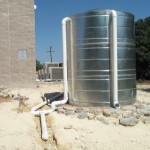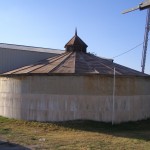There are several materials available for a storage container. Each has pros and cons, so you need to weigh the costs and benefits of each.
Corrugated Steel and Enclosed Metal
 Corrugated steel tanks are often used because of their availability, price, and aesthetic value. They can range in sizes from a few hundred gallons to tens of thousands of gallons. The large corrugated steel tanks are usually the support structure for a vinyl bladder on the inside which actually stores the water. The roof of these tanks, often conical, is usually not made strong enough to be walked on, so avoid getting on top of the tank. Because of their size, these tanks are usually assembled on-site.
Corrugated steel tanks are often used because of their availability, price, and aesthetic value. They can range in sizes from a few hundred gallons to tens of thousands of gallons. The large corrugated steel tanks are usually the support structure for a vinyl bladder on the inside which actually stores the water. The roof of these tanks, often conical, is usually not made strong enough to be walked on, so avoid getting on top of the tank. Because of their size, these tanks are usually assembled on-site.
 An enclosed metal tank is typically prefabricated and assembled off-site. The tank is sealed on the inside with a potable water approved liner or sealant. They are often more expensive than the corrugated tanks because they need to be shipped as a whole unit. The example on the left is galvanized steel.
An enclosed metal tank is typically prefabricated and assembled off-site. The tank is sealed on the inside with a potable water approved liner or sealant. They are often more expensive than the corrugated tanks because they need to be shipped as a whole unit. The example on the left is galvanized steel.
Concrete
 Concrete tanks are durable, strong, and heavy. They can be installed above ground or below ground. There are two common types of concrete storage containers: ferro-concrete and monolithic-pour concrete. Ferro-concrete is a relatively new approach where a special concrete mixture is sprayed on directly applied on a metal frame. This type of approach is common in developing nations.
Concrete tanks are durable, strong, and heavy. They can be installed above ground or below ground. There are two common types of concrete storage containers: ferro-concrete and monolithic-pour concrete. Ferro-concrete is a relatively new approach where a special concrete mixture is sprayed on directly applied on a metal frame. This type of approach is common in developing nations.
Monolithic-pour concrete tanks are either poured in place or prefabricated and assembled on site. An advantage to concrete is that they can raise the pH of the stored water. (rainwater is naturally acidic, so it actually neutralizes it)
Wooden
Although redwood tanks were once popular, they have become more expensive and less available. If located in a dry climate, the wood will dry and shrink, allowing water to leak out. To prevent leaking, the tank must be kept full, or lined.
Fiberglass
Fiberglass tanks are very versatile as they can be installed above or below ground. They are rigid and fairly lightweight and can be easily repaired. Because their individual strands are very fine and sharp, you should take be careful with parts that have been cut.
Polyethylene and Polypropylene (Plastic)
 Plastic tanks are the most common material used for residential RWH systems in Texas. This is because they are lightweight, come in many sizes and colors, and can are affordable. Polyethylene is flexible plastic and polypropylene is a rigid plastic. Both can be translucent or opaque. An opaque, solid color is better for reducing the chances of algae growth.
Plastic tanks are the most common material used for residential RWH systems in Texas. This is because they are lightweight, come in many sizes and colors, and can are affordable. Polyethylene is flexible plastic and polypropylene is a rigid plastic. Both can be translucent or opaque. An opaque, solid color is better for reducing the chances of algae growth.